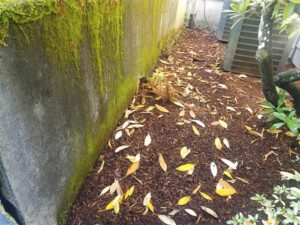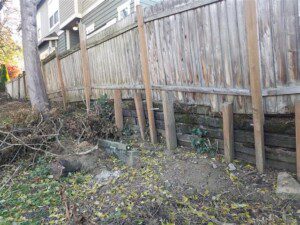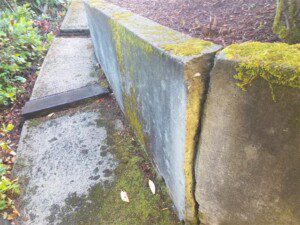
Installation of a proper and adequate retaining wall includes a lot more than piling some wood beams or concrete blocks up against a hillside. Important considerations such as drainage, anchoring, and material choice should be made when designing and installing a retaining wall.
Drainage is one of the most important considerations when designing a retaining wall. If there is no way for ground water to pass through or around a retaining wall, hydrostatic pressure will most definitely cause the wall to fail over time. Hydrostatic pressure is the pressure created by water in the soil that can build up behind a wall. Retaining walls that are stacked allow water to pass through gaps between the stacked materials, but solid concrete walls require weep holes and drainage channels to ensure that water pressure will not build up behind the wall. In both cases, having a drainage channel such as drainage tile and/or gravel backfill is required to encourage proper drainage.

Retaining walls can be made of many different types of materials, such as stacked rocks or stone, wood beams, wood wall structures, poured concrete or piled concrete blocks/pavers. The choice of materials should be according to the configuration of the surrounding soil, height, and length of the wall, and whether the retaining wall is supporting soil that is also supporting a structure above it. If a retaining wall is installed close to where a house is built, the load of the house could potentially create higher lateral loads against the wall.
Common retaining wall problems include:
Vertical joints
Rotating or leaning at the top.
Decayed wood.
Creosote containing wood walls.
Improper stacking materials.
Heaving concrete wall.

Inadequate drainage or weep holes.
Missing or inadequate anchoring.
Unless the retaining wall adversely affects the home, the inspection of retaining walls is outside the scope of a home inspection in Oregon and Washington per state law. However, your inspector may at their discretion (and without expanding the scope of their responsibilities) comment on visible defects as a courtesy. Our inspectors will inspect and comment on every retaining wall that can impact the home as repairing them can be labor intensive, require the use of heavy equipment, and can be very expensive.
Check out this video for more information about common retaining wall issues, and how to re-build a failed concrete block retaining wall.
